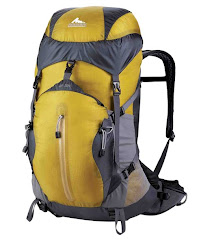
It can be difficult to determine the proper fit and lifespan of a backpack. However, this past weekend, Phil and I hoofed up and down the strenuous trail to Laurel Knob laden with a hefty rack and two ropes. Although we keep our rack as light as possible, the hike seemed particularly rough as I realized that my three year old backpack either was loaded with too much weight, or was loaded improperly, or the padding on the hip belt and shoulder straps had effectively died, or a combination of all of the above. The bad news is, I bitterly complained (in my head) the whole way to and from the crag and am still s
 ore a few days later.
ore a few days later.When I unloaded Phil's Black Diamond Sphinx from the car, I could tell a huge difference in his newer pack's padding. The good news is, while my backpack may have given me plenty of great memories on the Camino de Santiago and at crags all over the country, it is time for a shiny new one. I do have the satisfaction of knowing I go outside enough to honestly wear through my gear and being certain that my pack has served me well. Here are a few tips for fitting and using your backpack.
1. Breaking In Your Pack
Simply being sore from your backpack may not mean that your backpack is "dead" or fits improperly. I would strongly suggest that you gradually break in a new pack, or rather break yourself in to the pack, particularly if you are planning a long trip with significant loads. While you may be headed to a 500 mile excursion, your body may not be ready to hike long distances with a heavy load. Unless you hike with a fair amount of weight regularly, your body- everything from the skin on your feet to your hips and shoulders- needs to work up to carrying your fully loaded pack solid distances.
2. Don't Overload Yourself
At the Teton Valley Branch of NOLS, where Phil worked in Idaho as an Equipment Specialist for trips into the Bridger-Teto
 n National Forest, The Winds, The Sawtooths, and more, they recommended that hikers carry no more than 15 % of their body weight. Keep an eye out for this rule of thumb to avoid unnecessary strain on your body. A overladen pack can ruin the most beautiful of settings!
n National Forest, The Winds, The Sawtooths, and more, they recommended that hikers carry no more than 15 % of their body weight. Keep an eye out for this rule of thumb to avoid unnecessary strain on your body. A overladen pack can ruin the most beautiful of settings!3. Pack Smartly
Beyond just trying to keep it light, carefully consider weight distribution as you pack your backpack. A top heavy pack, a poking #4 Camelot, or a swaying trail rope can really alter your balance and put necessary strain on joints and muscles.
Happy Trails from Looking Glass Outfitters! I am off to get fitted for a new pack!















No comments:
Post a Comment